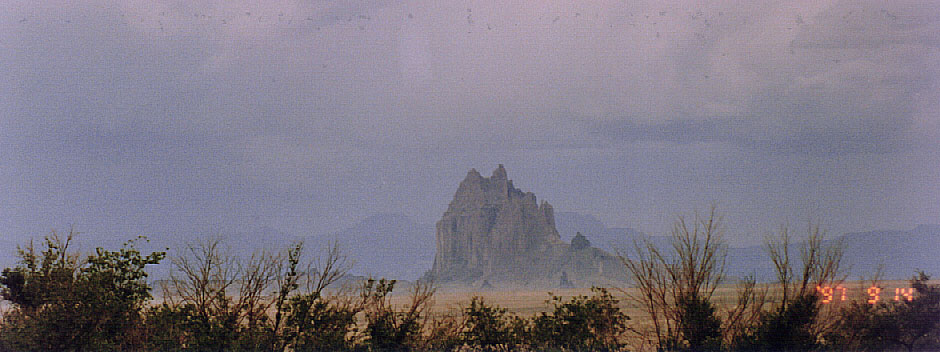Shiprock Peak is the "neck", or remains of a solidified lava core, of a dormant 40 million year old volcanic pinnacle. It is shaped somewhat like a 19th century Clipper Ship with high trap-dykes running north from Utah and south from the main spire and rising about 1,800 feet above the four-corners New Mexican plain. It's elevation is 7,178 feet above sea level. It lies about 13 miles southwest of the town of Shiprock, New Mexico, and 6 miles west of Highway 66. It is also visible from Dzil Ná'oodilii (Mountain Around Which Traveling was Done), which is about 40 to 50 miles east of Shiprock peak.
The pinnacle was called the Needle by Captain J.F. McComb in 1860. The name Shiprock apparently came into use in the 1870s as indicated by the U.S., Geological Survey Maps. The Anglo-Americans legend is that while they were in the area they noticed the similarity between the rock and the 19th century Clipper sailing ship of the time, giving it the name "Shiprock". Until October of 1939, its ragged and sheer sides had never been climbed. Climbers from the Sierra Club of California made the first ascent. Navajo beliefs resent such invasion of their sacred peak causing it to now to be illegal to climb. The following Navajo legend illustrates the reason why the Navajo (Diné) resent the climbing of their Tsé Bit' A'í:
A long time ago the Diné were hard pressed by their enemies. One night their medicine men prayed for their deliverance, having their prayers heard by the Gods. They caused the ground to rise, lifting the Diné, and moved the ground like a great wave into the east away from their enemies. It settled where Shiprock Peak now stands. These Navajos then lived on the top of this new mountain, only coming down to plant their fields and to get water.
For some time all went well. Then one day during a storm, and while the men were working in the fields, the trail up the rock was split off by lightning and only a sheer cliff was left. The women, children, and old men on the top slowly starved to death, leaving their bodies to settle there.
Therefore, because of this legend, the Navajos do not want any one to climb Shiprock Peak for fear of stirring up the ch’iidii, or rob their corpses.
Shiprock Peak has a number of other myths and ceremonies associated with it, these being the Bead Chant, the Naayéé’ee Ceremony, and the Enemy Side ceremony. The Naayéé’ee ceremony has a story of a large bird called, Tsénináhálééh (Picking Up Feathers), a bird that lived on top of Shiprock Peak and flew to Roof Butte (Dzil Dah Neeztínii - Where the Mountain Went Out on Top) to get men, never women. The bird went to Roof Butte every day. He is not at Shiprock Peak any more, but lives in the Sun’s house. He was the child of the Sun and Changing Women. There are also stories told of Shiprock Peak in the Enemy Side ceremony.


